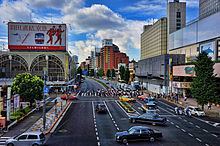Area 22.84 km² Prefecture Tokyo | Region Kantō Population 380,293 (1 Apr 2016) | |
 | ||
Time zone Japan Standard Time (UTC+9) Website www.city.shinagawa.tokyo.jp Points of interest Hara Museum of Contemp, Museum of Maritime Science, Sōya, Nikon Museum, Odaiba Colleges and Universities | ||
Shinagawa (品川区, Shinagawa-ku) is a special ward in Tokyo, Japan. While somewhat misleadingly referred to as Shinagawa City in bureaucratic English translations, it can be referred to as Shinagawa, as Shinagawa Ward, or (particularly in street addresses) as Shinagawa-ku. The ward is home to ten embassies.
Contents
- Map of Shinagawa Tokyo Japan
- Geography
- History
- Politics and government
- Corporate headquarters
- Other offices
- Former economic operations
- Places
- Higher education
- Primary and secondary education
- Important railway stations
- Rail
- Road
- Events
- Sister cities
- Others
- References
Map of Shinagawa, Tokyo, Japan
As of 1 April 2016, the ward has an estimated population of 380,293 and a population density of 16,510 persons per km². The total area is 22.84 km².
Geography
Shinagawa includes natural uplands and lowlands, as well as reclaimed land. The uplands are the eastern end of the Musashino Terrace. They include Shiba-Shirokanedai north of the Meguro River, Megurodai between the Meguro and Tachiai Rivers, and Ebaradai south of the Tachiai River.
The ward lies on Tokyo Bay. Its neighbors on land are all special wards of Tokyo: Kōtō to the east, Minato to the north, Meguro to the west, and Ōta to the south.
The ward consists of five districts:
History
Most of Tokyo east of the Imperial Palace is reclaimed land. A large portion of reclamation happened during the Edo period. Following the Meiji Restoration and the Abolition of the han system, Shinagawa prefecture was instituted in 1869. The prefectural administration was planned to be set up in present-day Shinagawa in the Ebara District. In 1871, Shinagawa prefecture was integrated into Tokyo Prefecture.
The ward was founded on March 15, 1947 through the administrative amalgamation of the former Ebara Ward with the former Shinagawa Ward. Both Ebara Ward and Shinagawa Ward had been created in 1932, with the outward expansion of the municipal boundaries of the Tokyo City following the 1923 Great Kantō earthquake.
In the Edo period, Shinagawa-juku was the first shukuba (post town) in the "53 Stations of the Tōkaidō" a traveler would reach after setting out from Nihonbashi on the Tōkaidō highway from Edo to Kyoto. The post-town function is retained today with several large hotels near the train station offering 6,000 hotel rooms, the largest concentration in the city. The Tokugawa shogunate maintained the Suzugamori execution grounds in Shinagawa.
The Tōkaidō Shinkansen high-speed rail line began serving Shinagawa Station in 2003.
Politics and government
Shinagawa is run by a city assembly of 40 elected members. The mayor as of 2007 is Takeshi Hamano, an independent. Liberal Democratic Party together with New Komeito currently forms government.
Corporate headquarters
Many companies are headquartered in Shinagawa. Isuzu, an auto manufacturer; JTB Corporation, a major travel agency; Nippon Light Metal, an aluminum and chemical products company; MOS Burger (in the ThinkPark Tower, Ōsaki); Lawson (East Tower of Gate City Ohsaki in Ōsaki), Namco Bandai Holdings; Namco Bandai Games; Banpresto; Rakuten, Honda brand Acura; Toyo Seikan, a packaging manufacturer; NSK Ltd., a bearing maker; Fuji Electric, an electrical equipment manufacturer; Imagica, a media post-production company; and Pola Cosmetics all have their headquarters within Shinagawa Ward. Marza Animation Planet also has its headquarters in Shinagawa.
Japan Airlines (JAL), the head office of its subsidiary JAL Hotels, and registered offices of JAL Express and JALways are located in the Tennōzu Isle area. In addition, Jalux, a subsidiary, has its head office in the I·S Building. One group of employees moved into the building on July 26, 2010, and one on August 2, 2010.
Other offices
Other companies maintain branch offices or research facilities in Shinagawa. Sony operates the Gotenyama Technology Center and the Osaki East Technology Center in Shinagawa. Sony used to have its headquarters in Shinagawa. Sony moved to Minato, Tokyo around the end of 2006 and closed the Osaki West Technology Center in Shinagawa around 2007. Adobe Systems maintains its Japan headquarters on the 19th Floor of Gate City Ohsaki near Ōsaki Station, while Siemens AG has its Japan offices in Takanawa Park Tower. Phoenix Technologies operates its Japan office on the 8th floor of the Gotanda NN Building in Gotanda. Siemens Japan and Philips also have offices in Shinagawa. Microsoft and ExxonMobil have their Japanese headquarters in Konan, Minato, near Shinagawa.
Former economic operations
Prior to its dissolution, JAL subsidiary Japan Asia Airways was also headquartered in the JAL Building. GEOS, an English language school company, once had its headquarters in Shinagawa. At one time Air Nippon had its headquarters in Shinagawa.
Places
Higher education
Primary and secondary education
Public elementary and junior high schools are operated by the Shinagawa Ward Board of Education. Public high schools are operated by the Tokyo Metropolitan Government Board of Education.
Important railway stations
Shinagawa Station in neighboring Minato also serves Shinagawa, and is a stop on the high-speed Tōkaidō Shinkansen line.
Rail
Road
Shinagawa is also home to the main motor vehicle registration facility for central Tokyo (located east of Samezu Station). As a result, many license plates in Tokyo are labeled with the name "Shinagawa."
Events
The abduction of Kiyoshi Kariya by the Aum Shinrikyo cult occurred in Shinagawa. On February 28, 1995, cult members abducted Kariya, a public employee, and took him to their facility in Kamikuishiki, Yamanashi. Cult members, including Ikuo Hayashi, injected Kariya with sodium thiopental in order to discover the location of the man's sister (a former Aum member), but Kariya unexpectedly died.
Sister cities
Shinagawa has sister-city relationships with Auckland in New Zealand, Geneva in Switzerland, and Portland, Maine in the United States.
Others
Shinagawa has exchange city relationships with Harbin in People's Republic of China and concludes "Hometown exchange agreement"(ふるさと交流協定) with Hayakawa and Yamakita towns.
